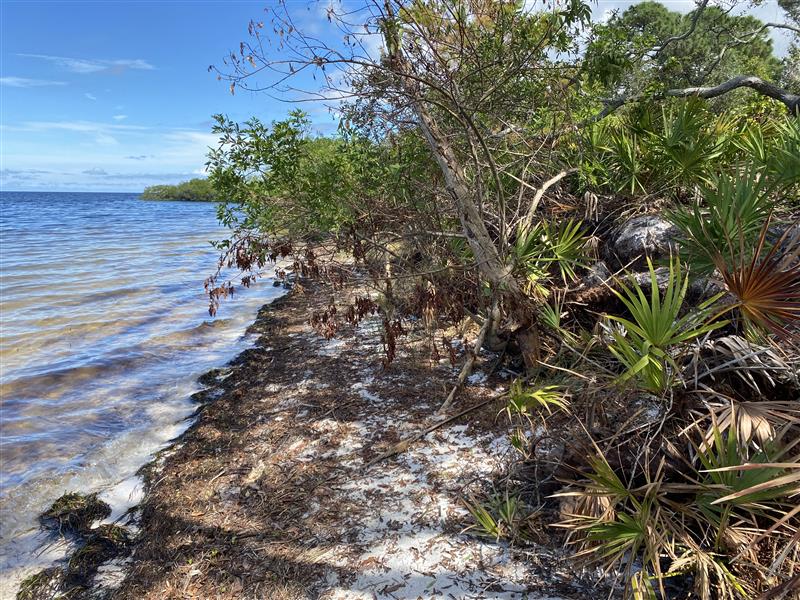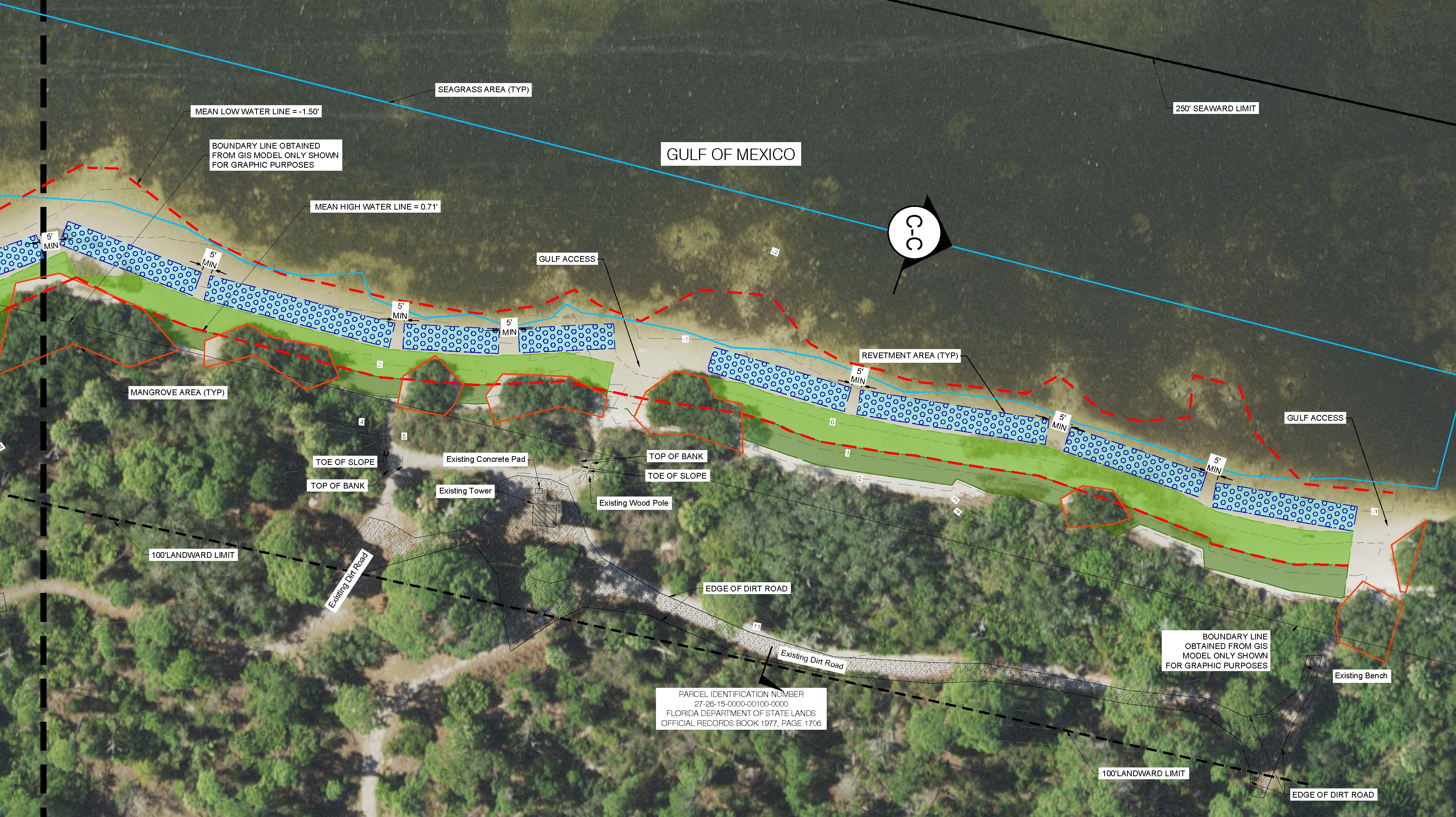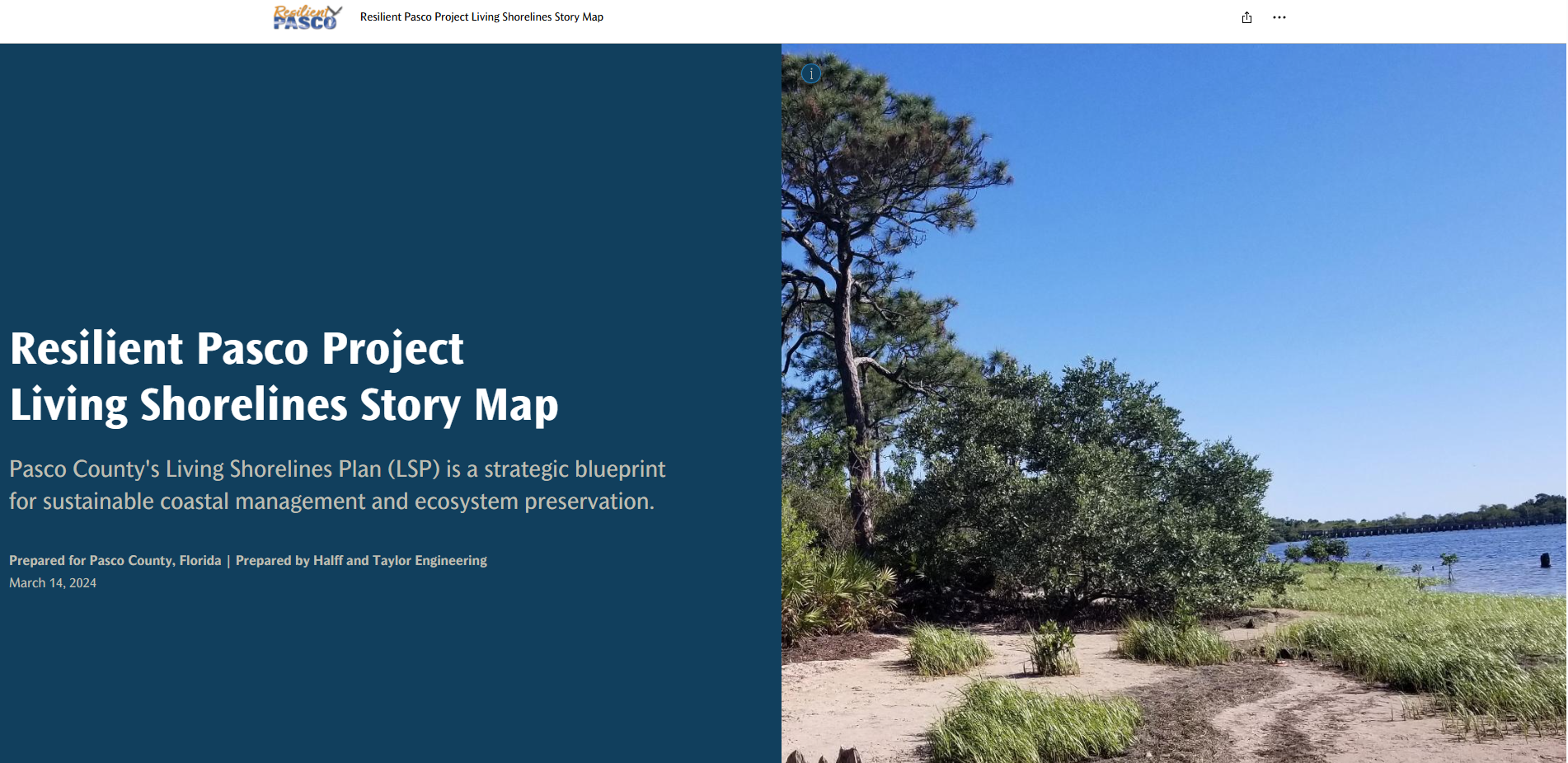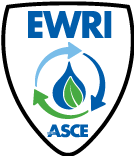Pasco County, located along Florida’s Gulf Coast north of Tampa Bay, faces increasing vulnerabilities to coastal flooding, erosion, and sea level rise. To address these challenges, the County launched the Resilient Pasco Project, its first comprehensive effort to develop a long-term resilience and sustainability framework. During the project’s planning process, hurricanes Idalia, Debby, Helene, and Milton impacted the region, revealing the fragility of infrastructure and natural systems and highlighting the urgency of strategies that protect communities while building long-term resilience. Among the project’s three interlinked deliverables—a Risk and Vulnerability Assessment (R&VA), a Resilience and Sustainability Action Plan (RSAP), and a Living Shorelines Plan (LSP)—the LSP specifically advanced nature-based solutions for protecting several of the County’s coastal parks, shorelines, and associated infrastructure.
The Living Shorelines Plan specifically focused on three public parks that exemplify the challenges faced by Gulf Coast communities: Anclote River Park, Key Vista Nature Park, and Robert K. Rees Memorial Park. These sites have historically experienced chronic erosion, storm surge impacts, and ecosystem degradation, amplified by hurricanes and ongoing sea level rise. The LSP was conceived not only to stabilize shorelines but also to restore ecological function, protect coastal resources, and enhance public access. Over a six-month planning period, the County convened a multidisciplinary team including environmental scientists, coastal engineers, surveyors, and local government officials. The team conducted site visits, surveyed subaquatic vegetation, analyzed shoreline conditions, and modeled current and projected storm surge and wave impacts. This comprehensive approach confirmed that the conceptual designs balanced flood risk reduction, habitat restoration, and feasibility within existing regulatory and geographic constraints.

At Anclote River Park, the conceptual design combined oyster bag breakwaters with native vegetation plantings along a low-energy shoreline. The oysters were suitable for the calmer conditions and were intended to dissipate wave energy, trap sediment, and support habitat development while the vegetation further stabilized the shoreline and enhanced ecological function. At Key Vista Nature Park, the LSP incorporated both structural elements and extensive plantings of mangroves and saltmarsh species. Because the site experiences higher wave energy, more robust erosion control features were paired with vegetation to rebuild natural buffers, reduce erosion, and promote biodiversity. Robert K. Rees Memorial Park faced high-energy conditions and a constrained shoreline due to a failing seawall and limited buffer width. The LSP recommended a hybrid approach that reinforced the seawall and layered in native plantings and living shoreline elements to absorb wave impacts, reduce erosion, and improve long-term resilience. Across all three locations, vegetation and structural components were used, but the type and scale of the structures were dictated by the site’s energy environment. Designs were informed by hurricane impacts, wave dynamics, and environmental sensitivity to confirm site-specific effectiveness.

The hurricanes that struck during the planning process provided real-time insights into the vulnerabilities of each park and underscored the urgency of resilient design. Observations from storm damage directly informed the placement and scale of living shoreline features, as well as the selection of materials and vegetation types capable of withstanding repeated storm events. These experiences highlighted the importance of adaptive management: living shorelines are dynamic systems, and ongoing monitoring and adjustments are essential to ensure long-term performance and ecological function.
Beyond physical design, the LSP emphasized policy integration and public engagement. Recommendations were made for incorporating living shoreline strategies into Pasco County’s comprehensive plan and code of ordinances, establishing regulatory support for nature-based solutions. A homeowner’s guide to living shorelines and a digital story map were produced to educate residents, highlight the planning process, and promote awareness of the benefits of natural shoreline stabilization. Multiple workshops, including public and stakeholder-specific sessions, confirmed that the LSP reflected community priorities, leveraged local knowledge, and built consensus around feasible strategies. This combination of technical planning, regulatory guidance, and community engagement positions Pasco County to implement living shoreline projects that are both effective and broadly supported.
The LSP represents a tangible example of how nature-based solutions can serve multiple objectives simultaneously. Oyster bags, mangroves, and saltmarsh vegetation not only stabilize shorelines and reduce wave impacts but also create valuable habitat for coastal species, enhance water quality, and provide recreational and educational opportunities for the public. By addressing both ecological and infrastructure needs, the LSP demonstrates the potential for resilient design to meet complex community goals in the face of changing coastal dynamics and repeated storm events.
Moving forward, the next steps for Pasco County include translating the conceptual designs into implementation projects. Detailed permitting considerations and guidelines developed during the LSP phase of the Resilient Pasco Project will provide guidance for navigating regulatory requirements. These resources, aligned with the County’s broader resilience framework, will help close gaps exposed by hurricanes and advance a long-term vision of coastal protection that integrates science, policy, and community engagement.

The Living Shorelines Plan within the Resilient Pasco Project illustrates the power of ecosystem-based approaches to coastal resilience. By combining technical analysis, field observation, innovative design, and collaborative engagement, Pasco County has created a model for communities seeking to protect both natural and built environments. The experiences gained during the planning process, particularly the lessons learned from four hurricane events, provide valuable insights for engineers, planners, and public officials navigating the challenges of coastal adaptation. As the Gulf Coast faces ongoing pressures from sea level rise and storm surge, the County’s focus on living shorelines demonstrates a forward-looking path toward safer, more resilient, and ecologically vibrant coastal communities.
Sean Lahav, MPA, WEDG, serves as Associate Vice President and Resilience Market Leader at Halff, a full-service infrastructure consulting firm with offices in Florida, Georgia, Louisiana, Arkansas, Oklahoma, Texas, and Arizona. Drew Sanders, WEDG, serves as Associate Vice President and Environmental Team Leader for Halff. Troy Dorman, PhD, PE, CFM, ENV SP, serves as Vice President and Director of Water Resources and Sustainability at Halff and is also a member of the EWRI Board of Directors.


